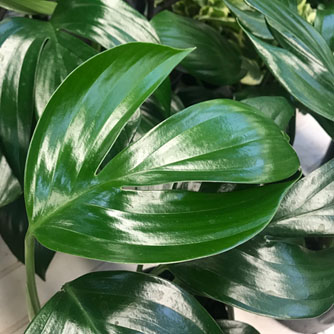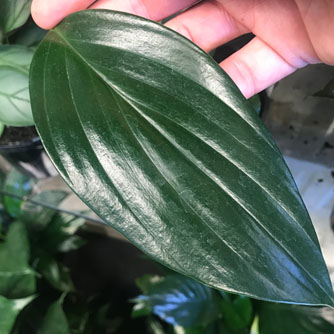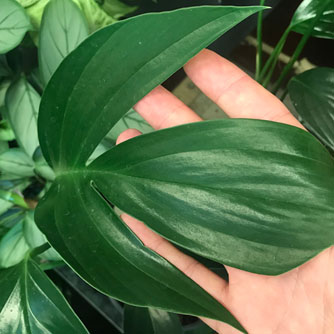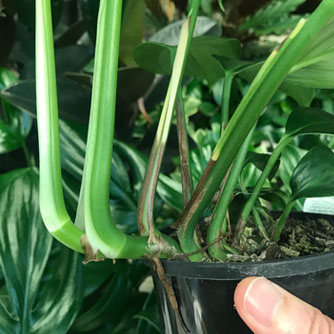Dragon Tail
BackDragon tail (Epipremnum pinnatum) is a native plant that you will definitely want to add to your indoor plant collection thanks to it’s interesting leaves. When young, they’re glossy and elliptical but as they mature they morph into deeply lobed leaves similar to a ‘dragon tail’ – if you use your imagination 🙂
Plants produce thick fleshy stems that will either crawl along the surface of the pot (and beyond) or climb up a totem if provided. Just remember to keep it away from small hands and furry paws as all parts are toxic.
How to Grow Dragon Tail
In the wild dragon tail grows as a forest floor dweller in tropical and subtropical climates so it loves warmth and humidity. However it is very adaptable and will also grow well indoors. Position in medium to bright light and out of direct sunlight. It will tolerate growing in low light but growth will be slowed. If the light is not adequate the spacing between the leaves will become elongated and sometimes the stem grows completely leafless. Clear signs the plant needs to be moved to a brighter spot.

Dragon tail with its lovely green foliage
Pot up using a premium quality potting mix and water in with OCP eco-seaweed to help the roots establish. Ongoing remember to water regularly and deeply ensuring water runs out the base of the pot. Between waterings allow the top 3-5cm of potting mix to dry out. Once established plants tolerate longer periods without water especially if positioned in a cool spot. Mist the leaves occasionally or group with other indoor plants to increase humidity. While this isn’t 100% necessary your plant will appreciate it.
To train your dragon tail to climb (instead of crawling across the pot) give it a totem made out of sphagnum moss or coconut fibre – you can either make one or purchase these from most nurseries. Stake the totem behind the plant and train the stem(s) to grow up the pole by securing with string or old hosiery. It will eventually grow roots into the totem, especially if the totem is regularly misted or watered. Alternatively you can support the stems with a wire trellis or bamboo poles.
In warm frost-free climates dragon tail can grow outdoors positioned in part shade. It can be kept in a pot or grown in a garden bed as a creeping groundcover but bear in mind that if there is a tree nearby it will likely start climbing. Ensure the soil is well-drained and improved with plenty of organic matter prior to planting.

Juvenile dragon tail leaf with smooth edges
Fertilising and Maintenance of Dragon Tail
During the warmer months feed with OCP eco-seaweed and OCP eco-aminogro every four weeks. If you want faster growth then increase feeding to every fortnight. Repot once every 1-2 years to give it room to grow. Choose the next pot size up, use a fresh potting mix and water in with eco-seaweed.
If your dragon tail is growing too wild for you or causing the pot to tip over you can always cut the stems back to try to keep the plant more neat and compact. Remember though that it’s naturally a trailing/climbing plant.
Propagating Dragon Tail
To propagate from stem cuttings use sharp secateurs to cut a length which has 2-3 leaves. Make the cut approximately 1.5cm below a node (the bump along the stem where a leaf normally appears). Remove the lower leaf and place the cutting in a jar of water with the bottom node submerged. Top up the water as needed to ensure the node is always covered with water. After 4-6 weeks roots should form. Once roots are 10-12cm long transplant into fresh potting mix and water in with OCP eco-seaweed. Cuttings can be taken at any time of the year but root formation will be fastest during the warmer months.

Mature dragon tail leaf with deep splits
Pests and Diseases of Dragon tail
These plants are pretty resilient but you may run into these issues:
- Mealybugs– this small white insect is a common pest on indoor plants and can usually be found in the leaf axils or on the undersides of leaves. If spotted then treat quickly with OCP eco-neem before they spread to other plants.
- Root rot or browning leaves – normally due to overwatering or a poorly drained potting mix. Reduce watering to allow the top 3-5cm of potting mix to dry out before watering again and don’t let water sit in the saucer or cover pot.
- Fungus gnats – another common pest with indoor plants. Drench the potting mix thoroughly with OCP eco-neem to kill the juveniles that live in the potting mix and to break the lifecycle.

Dragon tail ready to be trained up a totem


